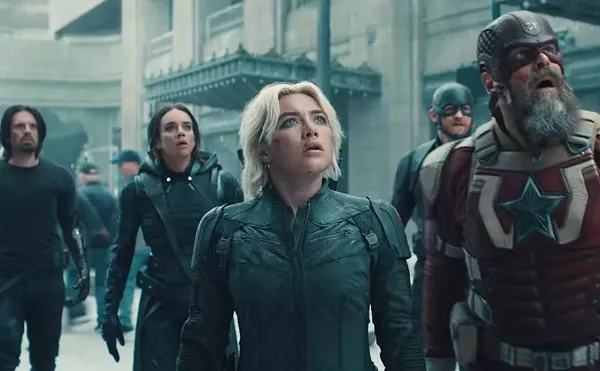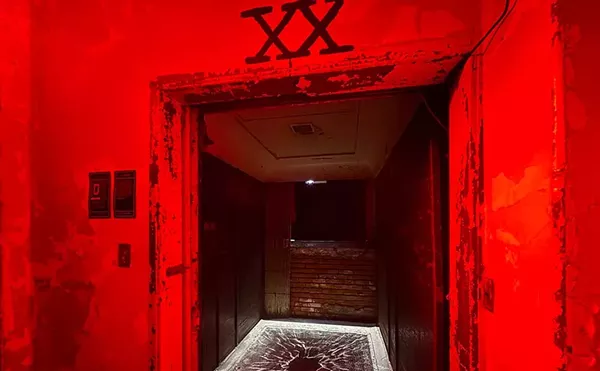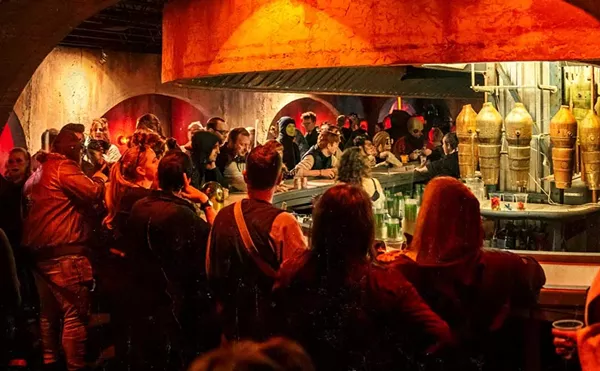
Audio By Carbonatix
[
{
"name": "GPT - Leaderboard - Inline - Content",
"component": "35519556",
"insertPoint": "5th",
"startingPoint": "3",
"requiredCountToDisplay": "3",
"maxInsertions": 100,
"adList": [
{
"adPreset": "LeaderboardInline"
}
]
}
]
If Tijuana at midnight on a weekend is an acid trip, Geoffrey James’ fascinating exhibition (at the Art Gallery of Windsor) of photographs taken along the U.S.-Mexico border is the afterglow.
It’s a comedown, indeed, for James locates the viewer on the Mexican side, looking in at America. Beginning at the Pacific Ocean, James follows a wall of corrugated metal along the border for 40 miles into the mountains. The wall is an absurdity – barely 3 meters high, it invites climbers. Where it peters out, one need only step around it and head for the hills.
"Pitchfork" Pat Buchanan, no slouch in photo-op opportunism, staged a memorable visit here during his run for the Republican presidential nomination in 1996. The blustery pundit glowered at the fissure with his usual mix of irony and scorn – aha, his face seemed to boast to the cameras, here is where all the jobs are leaving and all the wetbacks are scurrying in to take what few of them are left for real Americans!
The very provenance of the barrier’s building materials speaks to the confluence of America’s domestic paranoia about immigration and international paranoia about containment of forces that threaten American trade. In 1994, the U.S. Army Corps of Engineers constructing the fence exploited a surplus of corrugated metal sheets that had been used to make temporary landing strips during the Gulf War. From one desert of worry to another, as it were.
In a number of the photos, we see the stark contrast of intent between the Mexicans who build right up to the fence and the Americans who leave well enough alone. One man’s promise is another man’s threat. James heightens this paradox through the timeless look of his photographs. The land is eternal; the border belongs to the craven moods of history and its power brokers. Almost every image appears to have been shot at high noon, when the sun bleaches the landscape and the dry desert breeze throws up a gauze of dust. Walker Evans could well have shot these frames 50 years ago.
The focus is mercilessly deep, leaving the viewer to root around in the nooks and crannies of the frame for signifiers of modern life. More often than not, you find a border patrol Jeep looming off in the distance, waiting with craven patience for runners. As such, the fence is less an absurdity than a cruel joke, a rigged challenge, a taunt.
In one photo, a man is napping under the shadow of the wall with the infernal white beast perched on the other side of the river gully. What happened? Did he fall asleep during the night and fail to wake up in time for a stealthy escape? Or is he mocking the border patrol, showing indifference in the face of his inevitable return back to Mexico?
More chilling still are the images in which the fence is almost imperceptible. Now you see it, now you don’t, but you know it’s there. Simply by being in the landscape, the fence, rusted and sandblasted, has become part of the landscape.
Meanwhile, NAFTA has made the border more permeable and, hence, more dangerous. Tijuana and Ciudad Juarez, for all their legal maquiladoras (assembly plants), are also snake pits of criminal iniquity. If TVs and SUVs can cross the border easily, reason the drug lords, why not bales of marijuana and kilos of coke? Every day, photojournalists risk their lives in these cities to document the slew of wanton killings of drug cartel rivals and, more awful still, the young women who work in American-owned factories. Clearly, the misbegotten and unexpected reactions to global capital are running roughshod on the fence.
And if James is interested in another collection of photographs to complement this one, he would do well to get closer to the thunder.
E-mail comments to letters@metrotimes.com




